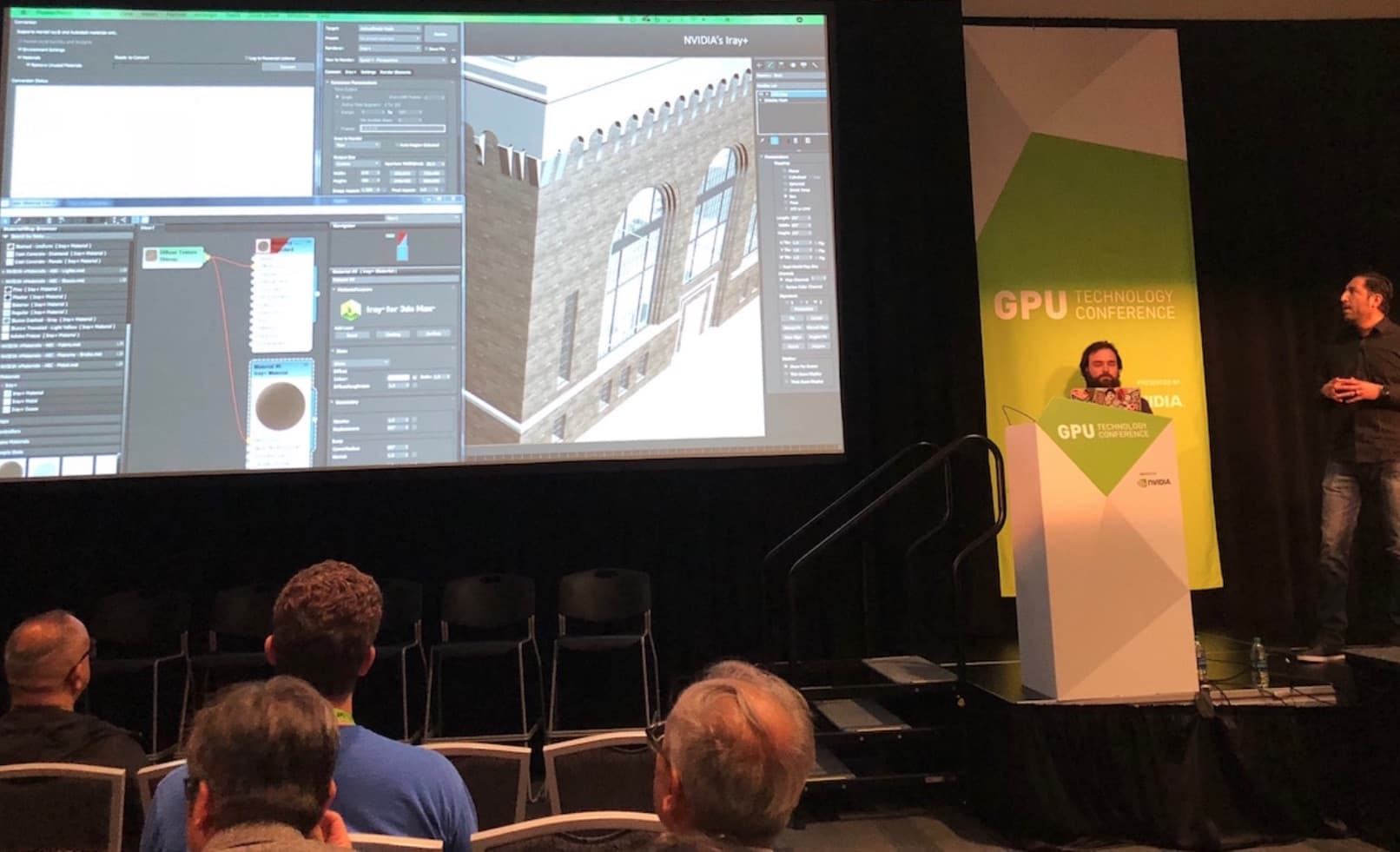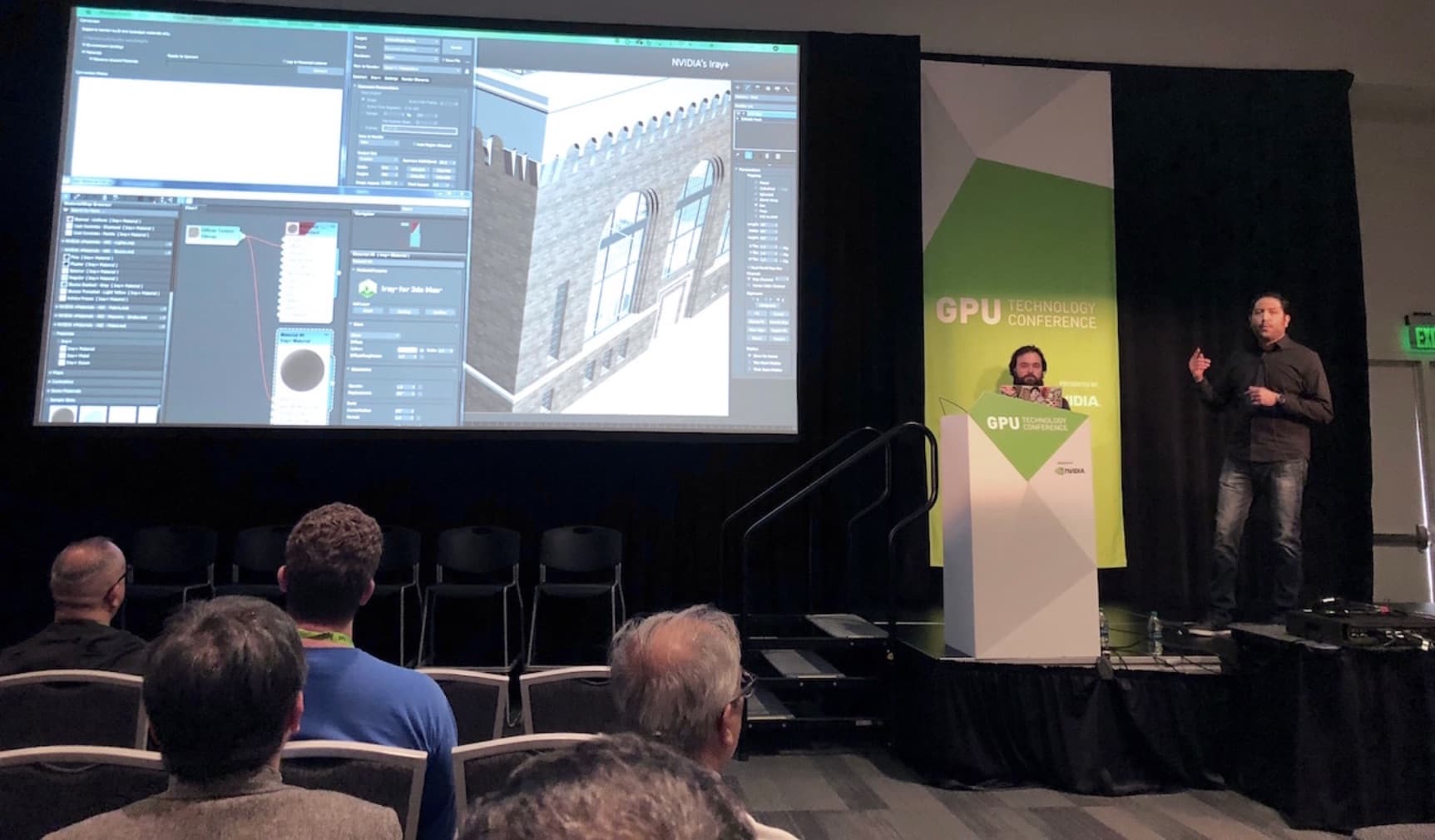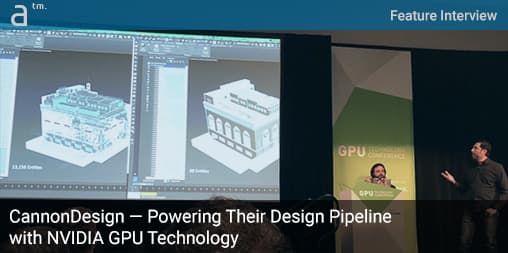FOUNDED OVER A CENTURY AGO in Niagara Falls, NY, CannonDesign has grown into a leading integrated global design practice working around the globe and in key market sectors including health, education, commercial, science + technology, sports, and community. CannonDesign stands out for its commitment to design excellence, technology integration and creative thinking. In 2017, Fast Company selected CannonDesign as one of the 10 most innovative architecture firms in the world.
CannonDesign’s recent projects include UC San Diego Health, Jacobs Medical Center, the University of Utah’s Lassonde Studios, the Centre Hospitalier de l’universite de Montreal (CHUM—the largest current P3 project in North America), workplaces for Uber, CJ Corporation’s Only One R&D Center and countless others. The firm can operate as a single team across 23 offices around the world using multiple technologies we will talk about today.

01 – Jimmy Rotella and Ernesto Pacheco from CannonDesign doing a presentation at the 2018 GTC. (image: Akiko Ashley / Architosh. All rights reserved.)
Jimmy Rotella and Ernesto Pacheco from CannonDesign share a brief look at the CannonDesign pipeline, the subjects of which were in their presentation at this year’s NVIDIA GTC 2018 conference.
The Interview
(Akiko Ashley) Can you tell me a little about your role in CannonDesign?
(Jimmy) I’m the Digital Practice Director for the firm. I usually explain the Digital Practice group as the intersection of technology and design for our company. I lead and oversee design technology-related efforts which range from managing the software we use, vetting new software, developing processes and workflows to use our tools, teaching people best practices, and exploring new technologies. My role touches a lot of things throughout the entire company, and because it’s so far-reaching I have to work closely with a lot of people to coordinate our efforts and make sure everything works together.
The majority of our designers leverage our virtual desktop infrastructure as their everyday workstations, and they are powered by Quadro Virtual Data Center Workstation technology (formerly known as GRID).
(Ernesto) I’m the Design Visualization Lead at CannonDesign. I’m responsible for the research and implementation of new technologies and software into our visualization workflow. Lately, I have been heavily involved with the development of VR and AR experience for job interviews and design meetings. I’m currently directing our rendering an animation efforts firm-wide.
Do you use the NVIDIA graphics cards in your pipeline and is it on the user’s machine or built into your server farm?
(Jimmy) We have a lot of different workflows and pipelines, hence we require multiple solutions to facilitate them; however, almost all of them are heavily reliant on graphics power and utilize NVIDIA graphics. The majority of our designers leverage our virtual desktop infrastructure as their everyday workstations, and they are powered by Quadro Virtual Data Center Workstation technology (formerly known as GRID). This gives them the power they need, along with the flexibility to work anywhere, and we get much better management capabilities when compared to a desktop environment.
Our other solution is designed for our high-end graphics users who are also working with virtual reality on a regular basis. These end users work on physical desktops powered by NVIDIA Quadro cards. Because of the latency requirements of today’s VR headsets, we can’t yet use that technology on our VDI’s, so physical workstations are our only option for any virtual reality solutions.
(Ernesto) We use NVIDIA graphics cards exclusively both on local machines as well as on our server farm.
When did CannonDesign implement a VDI solution and what were some of the obstacles along the way?
(Jimmy) Our initial implementation was around 2007, but we were fully virtualized by 2011. Our upgrade and build-out of our new data center—which our talk centers around—was in 2015. The biggest obstacle was testing and making sure the solution provided a good experience for our end users in their design workflows. In our early implementation, virtual desktop solutions were not tailored to graphics-intensive workflows, but rather suited to traditional “office task work.” We had to prove this solution would work for our design tools also.
How long have you used the Holodeck VR and have you used it on a project yet?
(Ernesto) We have been involved with the development of tools geared towards AEC with NVIDIA since the early access build of Holodeck. We have used it on internal projects only.
What would you like to see in the Holodeck VR software to help you better?
(Ernesto) Better navigation tools tailored for architectural visualization.

02 – CannonDesign presentation at 2018 GTC on the NVIDIA Holodeck VR software solution. (image: Akiko Ashley / Architosh. All rights reserved.)
(Jimmy) Not sure how much detail we can go into regarding this, but the main thing we addressed in our presentation was the need to streamline the import process into the Holodeck from 3d modeling platforms.
Do you think VR, AR, or MR will be first to become familiar in the marketplace? And why do you think this?
(Jimmy) Honestly, I think they are all already becoming familiar in the marketplace. Right now each serves different purposes and leverages different platforms, therefore they are all being used and experimented with in the marketplace. In my opinion, I think a much more advanced form of AR is where we are going to end up, just because I think it’s the most flexible and will have the broadest application to people’s everyday lives. However, we’re not going to get there until the hardware associated with it is more similar to an everyday pair of glasses.
(Ernesto) AR is widely used by consumers nowadays and I think it will only continue to get better. IKEA is the best example of the leverage of this technology via their app. MR will most likely take on once HMDs become lighter and fashionable.
Can you tell me what key hardware you use and can’t live without, and your key software packages?
(Jimmy) Our virtual infrastructure is a very important part of our workflows. Without that, we would not be able to accomplish our SFMO (single firm, multi-office) model. It really is what allows us to collaborate on projects regardless of location and at a level that would be otherwise impossible.
AR is widely used by consumers nowadays and I think it will only continue to get better. IKEA is the best example of the leverage of this technology via their app.
As for key software packages, our primary authoring tool is Revit. That’s really what we use to create our construction documents and models, which at the end of the day, is what we are getting paid for.
(Ernesto) I have a Cintiq Wacom tablet that I use for post-processing tasks in Photoshop and After Effects as well as 3D modeling. My key software packages are 3dsmax, Modo, and Unreal Engine
Can you tell us briefly how CannonDesign starts a project and where does it enter the technology pipeline and what happens next?
(Jimmy) Most of our projects still start as sketches and ideas. Sometimes those are captures in analog on trace paper or drawings, but sometimes they start directly in the technology pipeline via digital sketches.
Advertisement
After that, they often move into more of a schematic phase, where those digital or analog sketches are recreated in 3d masses in programs like Rhino, Sketchup, or sometimes directly in Revit to be further developed.
Can you talk about key a project or projects and how you use technology to accomplish getting them done more efficiently?
(Jimmy) Last summer we were approached by one of our design leaders with a task given to him by the USI Athletic Director, John Mark Hall. The task was to have CannonDesign deliver a virtual reality tour of the proposed arena to their current and potential corporate donors during a dinner event. He also had requested a 2-minute walkthrough animation for use in future articles on the arena as well as for social media. We planned the presentation to be led by one of our design leaders with a surprise guest appearance by one of the USI basketball stars.

03 – Jimmy Rotella and Ernesto Pacheco from CannonDesign presenting at 2018 GTC. (image: Akiko Ashley / Architosh. All rights reserved.)
The task was nothing less than monumental as we were given only a month and a half to put all of this together. We had developed a couple of VR experiences with the Oculus Rift before. However, this time we had to develop the project using the HTC Vive, which presented a new set of challenges. Having access to the right software and assets allowed us to expedite most of the initial tasks. This was true especially during UV mapping as this project required a huge amount of costume environmental graphics on walls, floors, ceilings, and even glass.
At the end of the event, the Athletic Director thanked us for all the work and was very excited to share the animation and video of the presentation with others. He also saw the potential for this type of technology as a recruiting tool. Eventually, he requested a lighter mobile deployment of the VR experience that he could take with him to recruiting events.
Thank you Jimmy and Ernesto for this wonderful conversation. What a brilliant group of talent you have at CannonDesign.




Reader Comments
Comments for this story are closed